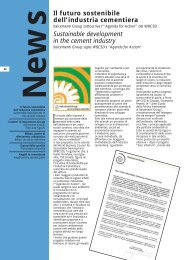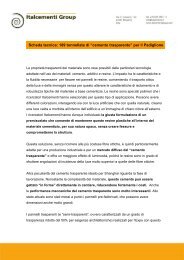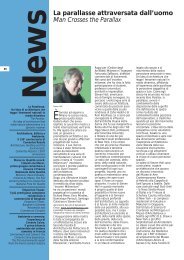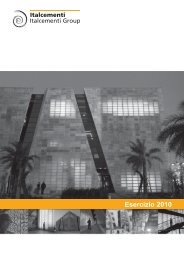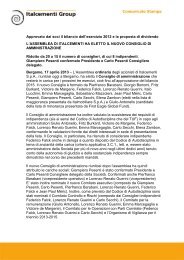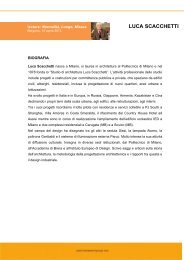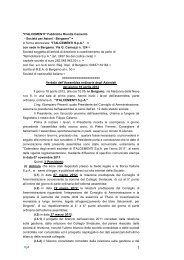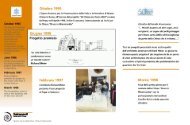2011 Annual Report - Italcementi Group
2011 Annual Report - Italcementi Group
2011 Annual Report - Italcementi Group
Create successful ePaper yourself
Turn your PDF publications into a flip-book with our unique Google optimized e-Paper software.
1.2. Accounting policies and basis of presentation<br />
The accounts adopt the cost principle, with the exception of derivatives and financial assets held for trading or<br />
for sale, which are stated at fair value. The carrying amounts of hedged assets and liabilities are adjusted to<br />
reflect changes in fair value on the basis of the hedged risks. The financial statements are presented in euro.<br />
All amounts in the accounting schedules and in the notes are rounded to thousands of euro, unless otherwise<br />
specified.<br />
The basis of presentation of the financial statements is as follows:<br />
current and non-current assets and current and non-current liabilities are presented as separate<br />
classifications on the face of the statement of financial position. Current assets, which include cash and<br />
cash equivalents, are assets that the company intends to realize, sell or consume during its normal<br />
business cycle; current liabilities are liabilities that the company expects to settle during the normal<br />
business cycle or in the twelve months after the end of the reporting period;<br />
on the income statement, costs are analyzed by the nature of the expense;<br />
on the statement of cash flows, the indirect method is used.<br />
Since the <strong>Italcementi</strong> <strong>Group</strong> applies IAS 34 “Interim Financial <strong>Report</strong>ing” to its half-year reports, with the<br />
consequent identification of a six-month interim period, any reductions in value are recorded at closure of the<br />
half year.<br />
1.3. Use of estimates<br />
The preparation of the separate financial statements and the notes in conformity with the international financial<br />
reporting standards requires management to make estimates that affect the carrying amounts of assets,<br />
liabilities, income and expense, such as amortization, depreciation and provisions, and the disclosures on<br />
contingent assets and liabilities in the notes. Since these estimates are determined on a going-concern basis,<br />
using the information available at the time, they could diverge from the actual future results. This is particularly<br />
evident in the present financial and economic crisis, which could generate situations diverging from those<br />
estimated today and require currently unforeseeable adjustments, including adjustments of a material nature,<br />
to the carrying amounts of the items in question. Assumptions and estimates are particularly sensitive with<br />
regard to measurement of non-current assets, which depend on forecasts of future results and cash flows,<br />
provisions for disputes and restructurings and commitments in respect of pension plans and other long-term<br />
benefits. Management conducts regular reviews of assumptions and estimates, and immediately recognizes<br />
any adjustments in the financial statements.<br />
1.4. General policies<br />
Subsidiaries and associates<br />
Subsidiaries are companies in which the company has the power to determine, directly or indirectly,<br />
administrative and management decisions and to obtain the benefits thereof. Generally speaking, control is<br />
assumed to exist when the company holds, directly or indirectly, more than one half of voting rights, including<br />
potential voting rights deriving from convertible securities. Associates are companies in which the company<br />
has significant influence over administrative and management decisions even though it does not hold control.<br />
Generally speaking, significant influence is assumed to exist when the company holds, directly or indirectly, at<br />
least 20% of voting rights or, even if it holds a lower percentage of voting rights, when it is entitled to take part<br />
in financial and management policy decisions by virtue of a specific juridical status including, but not limited to,<br />
participation in voting trusts or other forms of material exercise of rights of governance.<br />
Investments in subsidiaries and associates are measured using the cost method, whereby they are recognized<br />
initially at cost, and subsequently adjusted to reflect changes in amount whenever, following impairment<br />
testing, conditions are found such as to make it necessary to adjust the carrying amount to the effective value<br />
248






